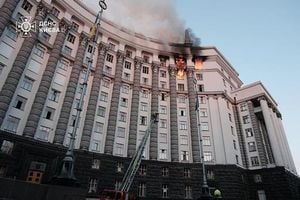On September 1, 2025, the world watched as Indian Prime Minister Narendra Modi clasped hands with Russian President Vladimir Putin during the Shanghai Cooperation Organization (SCO) Summit in Tianjin, China. The moment, captured by Reuters and widely circulated, was more than just a friendly gesture—it was a powerful symbol of shifting alliances and complicated geopolitics. The summit, hosted by Chinese President Xi Jinping, brought together leaders from across Eurasia, but the body language and warmth between Modi, Putin, and Xi sent a clear message to Washington and Brussels alike.
According to Reuters, the affectionate display between Modi and Putin—complete with handholding and smiles—sparked unease in European capitals. For years, the European Union has tried to woo India away from its traditional partnership with Russia, hoping to draw New Delhi closer to the West’s orbit. Yet, as the images from Tianjin show, India’s ties to Moscow remain robust, even as global tensions rise and trade disputes simmer.
But the story doesn’t end with Europe’s discomfort. The summit unfolded just days after U.S. President Donald Trump imposed a hefty 50% tariff on Indian goods, escalating a trade spat that has already strained relations between Washington and New Delhi. Modi’s high-profile meetings with both Putin and Xi—his first visit to China in seven years—were widely interpreted as a direct response to Trump’s economic pressure. As Fox News reported, Modi was pictured not only holding hands with Putin and Xi but also taking a ride in Putin’s presidential limousine, a gesture reminiscent of Putin’s recent visit with Trump in Alaska.
In a post on X (formerly Twitter), Modi shared a photo of himself with Putin, writing, "Conversations with him are always insightful." Putin, for his part, was equally effusive, calling Modi his "dear friend" and expressing gratitude that India and Russia share "friendly and trusting" relations. The camaraderie was unmistakable, and analysts quickly noted the significance of such open displays of warmth at a moment when India’s relations with the West are under strain.
Xi Jinping, the summit host, also weighed in with a pointed speech. Without naming the United States, he condemned "bullying behavior" by countries—an unmistakable jab at the recent spate of tariffs and sanctions that have characterized Trump’s approach to global trade. China has long sought to use the SCO as a counterweight to U.S. and NATO influence, and this year’s summit was no exception. By bringing Modi, Putin, and other leaders together in Tianjin, Xi underscored Beijing’s ambition to lead a new bloc of non-Western powers.
Trump, never one to shy away from a public spat, responded quickly. On September 1, he took to social media to argue that India had more to lose in the economic standoff. "What few people understand is that we do very little business with India, but they do a tremendous amount of business with us," Trump wrote. "They have offered to cut their tariffs to nothing, but it’s getting late. They should have done so years ago. Just some simple facts for people to ponder!"
The timing of Modi’s meetings was hardly coincidental. In the weeks leading up to the summit, India’s national security advisor traveled to Moscow, the country’s foreign minister visited Russia, and Chinese Foreign Minister Wang Yi concluded talks in Delhi. These diplomatic flurries suggest that India is hedging its bets in an increasingly multipolar world, seeking to balance its relationships with the U.S., Russia, and China.
For Europe, the images from Tianjin were a sobering reminder of the limits of its influence. The European Union has suffered collateral damage from the U.S.-India trade spat, with some analysts pointing out that the West’s efforts to draw India closer may be backfiring. Instead of isolating Russia, the current dynamic appears to be strengthening the ties between Moscow, Beijing, and New Delhi.
Yet, as some experts have pointed out, the situation isn’t entirely bleak for the West. India remains a democracy with deep economic ties to Europe and the United States. The current round of diplomacy may be more about signaling and leverage than a wholesale realignment. As one European diplomat told Nikkei Asia, "India wants to keep all its options open. They’re not about to abandon the West, but they also won’t be bullied into submission."
Still, the optics matter. Modi’s willingness to embrace both Putin and Xi—literally and figuratively—at a time of heightened global tension has complicated the narrative for Western policymakers. The fact that Modi’s visit to China was his first in seven years only adds to the significance. By participating so enthusiastically in the SCO summit, India is signaling that it won’t be easily swayed by U.S. pressure or European overtures.
Looking ahead, the diplomatic dance is set to continue. Putin is expected to host Modi in Moscow before the end of 2025, further cementing the close relationship between the two countries. Meanwhile, the U.S. and India will have to navigate the fallout from the ongoing tariff dispute, with Trump insisting that America is India’s "biggest client" but warning that the window for compromise is closing fast.
Back in Tianjin, the mood among the SCO leaders was one of cautious optimism. While the group has often struggled to match the influence of Western alliances, this year’s summit felt different. With Modi, Putin, and Xi presenting a united front—at least for the cameras—the message to Washington and Brussels was unmistakable: the world is changing, and old alliances are no longer set in stone.
For ordinary Indians, the diplomatic maneuvering may seem distant, but the stakes are real. Trade tariffs, shifting alliances, and diplomatic spats have direct consequences for jobs, prices, and security. As the world’s largest democracy charts its course in a turbulent era, the choices made in Tianjin and beyond will reverberate far beyond the summit halls.
As 2025 unfolds, one thing is clear: India is determined to assert its independence on the world stage—sometimes by holding hands, sometimes by holding firm. The rest of the world would do well to pay attention.




